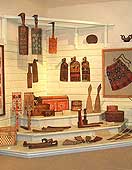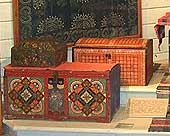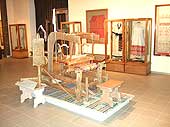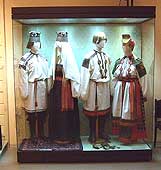The World of a Russian Village
(folk art in people’s life: rituals, traditions, feasts), (p. 3)
The second hall. Continuation
 For little children the Museum organizes Sunday master-classes in making a traditional peasant rag doll. The professional artist combines the class with a detailed story about the doll, its history and sacral meaning echoed in folk tales.
For little children the Museum organizes Sunday master-classes in making a traditional peasant rag doll. The professional artist combines the class with a detailed story about the doll, its history and sacral meaning echoed in folk tales.
 The large part of the exhibition is dedicated to the wedding ritual. The new family was never a private affair. It was a ritual of social significance. Peasant children were prepared for the future family life from the earliest age. Girls of 7-8 learned to take part in preparation of their dowry that depended on the family welfare.
The exposition reflects this theme in a certain group of meaningful items: distaffs, scutchers, smoothers, richly decorated with scenes of
young people gathering and match-making from the Northern and Volga Areas; towels with ornamental childbirth symbols and chests containing dowry.
The large part of the exhibition is dedicated to the wedding ritual. The new family was never a private affair. It was a ritual of social significance. Peasant children were prepared for the future family life from the earliest age. Girls of 7-8 learned to take part in preparation of their dowry that depended on the family welfare.
The exposition reflects this theme in a certain group of meaningful items: distaffs, scutchers, smoothers, richly decorated with scenes of
young people gathering and match-making from the Northern and Volga Areas; towels with ornamental childbirth symbols and chests containing dowry.
 According to the old tradition, a girl made home-spun canvases for her wedding dress. The Museum visitors can see inter-active exhibits of the early 20th century from the Vyatka Province. They help to illustrate the process of canvas production. The scutcher was used to clean flax stems of the ruff cover. The distaff and spindle were used for spinning. The loom is still used by the experienced weaver demonstrating the production of multi-colored rugs.
According to the old tradition, a girl made home-spun canvases for her wedding dress. The Museum visitors can see inter-active exhibits of the early 20th century from the Vyatka Province. They help to illustrate the process of canvas production. The scutcher was used to clean flax stems of the ruff cover. The distaff and spindle were used for spinning. The loom is still used by the experienced weaver demonstrating the production of multi-colored rugs.
 Young people of marriage age took an active part in chat-in parties, round dances and games. The valuable collection of gala costumes is displayed like a round dance. It presents dresses of the 19th – early 20th century from the northern provinces of Russia and wedding costumes of the early 20th century from the Voronezh Province. The wedding costumes are distinguished by numerous articles, bright colors and rich ornamentation full of good-minded symbols.
Young people of marriage age took an active part in chat-in parties, round dances and games. The valuable collection of gala costumes is displayed like a round dance. It presents dresses of the 19th – early 20th century from the northern provinces of Russia and wedding costumes of the early 20th century from the Voronezh Province. The wedding costumes are distinguished by numerous articles, bright colors and rich ornamentation full of good-minded symbols.
 Peasants preserved their wedding costumes carefully through the whole life. They were often used as burial clothes. There was a saying “to die in one’s wedding costume”. The ancient beliefs in “the other world” are illustrated by the items traditionally put in the coffin: a block of soap, comb, coins – so that the departed could use them there.
A separate group of exhibits includes tomb crosses and towels bearing embroidered tomb crosses with blowing flowers at the ends, symbolizing beliefs in immortal soul.
Peasants preserved their wedding costumes carefully through the whole life. They were often used as burial clothes. There was a saying “to die in one’s wedding costume”. The ancient beliefs in “the other world” are illustrated by the items traditionally put in the coffin: a block of soap, comb, coins – so that the departed could use them there.
A separate group of exhibits includes tomb crosses and towels bearing embroidered tomb crosses with blowing flowers at the ends, symbolizing beliefs in immortal soul.
|


